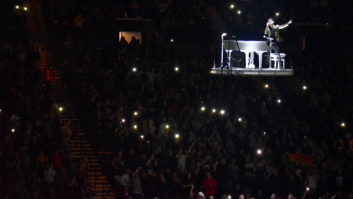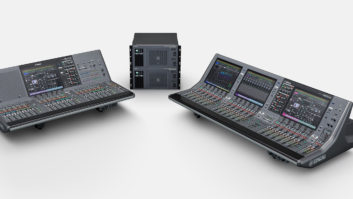Dance Pop hits tend to be ephemeral things—quick musical bursts of good times that usually leave the artist forever defined (and trapped) by that era and sound. But standing in the crowd at Barclays Center in Brooklyn, NY one evening in early winter, it was clear that Janet Jackson didn’t get the memo. As she knocked out hit after hit to the sold-out crowd, it was a not-so-subtle reminder of just how long and far-reaching her career has been. When you bring all those smashs together for a 40-plus song set, it’s suddenly easy to spot a career-long throughline of razor-sharp production and lyrics charting politics both societal and personal—and then see how she’s made them her trademarks. More importantly, while some of those hits may have been around for more than three decades, the songs still accomplish their ultimate goal: They make you get up and dance.
Bringing those tunes to the crowd each night was FOH engineer Kyle Hamilton, who’s spent the last 24 years mixing the likes of Pharrell Williams, Kendrick Lamar, Prince, Lionel Richie, Mary J. Blige and Rihanna, to name only a few. Manning a DiGiCo SD7, Hamilton spent each show recreating the massive Eighties production of Jackon’s early hits and the smoother but no less meticulous sounds of chart-toppers from more recent times. That’s no accident: “When [producers] Jimmy Jam and Terry Lewis are standing right next to me, they want to hear their record! When I give Janet her two-mix of the night, she wants to hear her record, with a live feel of course. All those signature sounds, the little things that put you back into the moment where you first heard that record? That’s what we strive to do, night in and night out.”
That’s a tall order, given Jam and Lewis’ impeccable production, but it was a challenge that the whole production focused on: “You have to keep sounding it true to then,” said Hamilton. “Even with drum triggers, they’re the actual sound; nothing is recreated. An Eighties snare, a mid-Nineties snare, a Nineties kick? They each have their own texture and timbre, so we don’t try and recreate that; we strip that out, edit it up and make that sound.”
The result of all that sonic information was that the show had 32 channels of Pro Tools supplementing the nine musicians onstage, giving Hamilton an abundance of material to work with: “We have about 110 inputs total; it’s a lot of music from Pro Tools and the band, so to make that merger come to life, we have a lot of separation. Stems can’t be all merged together, so I spread everything out like you would the record, so that we can bring the balance back to life—because everything that sounds good in-ear or in a nearfield situation may not translate out here in the house.”

That in turn altered his mixing style for the tour. While as adept with popular plug-ins as the next guy, Hamilton largely eschews them for Jackson tours for the simple reason that much of the material has already been effected. “At the end of the day, this house is a big reverb chamber, so when he hits the snare, I don’t have to add it—we’re already there!” he said with a laugh. “For me to do it twice would be overkill and it takes away from the trueness of the music. OK, you used a plug-in to make a great recording, capture a moment and it’s printed on to that stem. That moment’s already done, so what am I going to do at 102-105 dB? If I do the same thing, it’s not going to translate, right? It’ll sound like you’ve added delay, added latency on something. You start to change what the sound really was.”
Make no mistake—the musicians onstage generated plenty of sound on their own, with Jackson’s vocal captured alternately via a Sennheiser 2000 Series handheld wireless with a 5235 capsule or a Sennheiser HSP 4 headset mic. “She’s soft spoken, but she has great mic technique; she knows when to dig in,” said Hamilton. “I also run her through Avalons to give her that feel of the studio vocal. Sometimes stuff has a tendency to feel a little distant, so that’s my trick to bring it to the forefront—that makes it sound nice and tight and in your face.”
‘In your face’ is key, especially with dance music, so Hamilton had 22 mics on the drum kit alone: “I do close miking; I don’t have overhead mics in the stratosphere. Because of the era of the music, we have enough reverb on everything, so we want our pulse to be nice and tight. The gates are real tight on my drums—almost no decay, in and out—and I let the room do the rest. Also, the hi-hat work is quite important to her music and you need to hear that, so all the brass is close-miked, not just the two crashes and the ride; you hear the splashes and everything else. When you see the drum kit played in the show, whatever he hits, you hear!”

Ensuring that everyone heard it was a sizable Clair Global PA based around Cohesion CO-12s in the main arrays, side arrays of I-3s, 16 powered CP218 subwoofers across the front of the stage, and eight P2 frontfills, all overseen by crew chief/systems engineer Matt Van Hook. “The CO-12 was a step forward as to how little work I have to put into it to get an even result every day,” Van Hook enthused. “It goes up quickly, and when I turn it on, it comes out very flat and doesn’t take long to get really good results. They’ve taken the time to draw all the venues so when I come in in the morning, I don’t have to spend 90 minutes drawing the room. I just have to input the speaker configuration data into the software, which takes me 10 minutes.”
Helping ensure that the PA covered every seat, the hangs had green lasers atop them to verify the math. “The PAs are incredibly accurate,” said Van Hook, “so I’ll point those lasers literally 4 feet above the last row of chairs and walk up there. You’re in the high end—and then you stand on the chair and it goes away; it’s that accurate.” The lasers were accessed via a web-based GUI, allowing Van Hook to simply turn on his smartphone’s Wi-Fi, open his web browser and turn the lasers on and off as needed to check his work.
Exhibiting at the 2018 NAB Show? Enter the NewBay Best of Show Awards! EXTENDED DEADLINE: MARCH 30!!!
Thoughtful design all around—from lasers helping speed things up to new simplified custom amp rack designs—helped ensure that the production ran like clockwork, day in and day out: “We are 38 shows into a 56-show run, so everyone knows their exact movements,” said Van Hook. “Today, the truck didn’t even dump until noon, and we were complete and timed and tuned by 2PM.”
And all that hard work culminated every night in a show that carried the crowd out of the arena to another place. “It’s an emotional rollercoaster from when you were a kid until now with all those songs, and to have mixed her for the last almost eight years now has been a blessing,” said Hamilton. “With Janet, you want to get them up and make ’em party for the entire two hours, because when you see her, it’s not just a show—you get an experience!”
Clair Global • www.clairglobal.com
DiGiCo • www.digico.biz
VITAL STATS: Janet Jackson • Clair Gloabl (Lititz, PA)
FOH Engineer: Kyle Hamilton
Monitor Engineer: Jim Roach
Crew Chief/System Engineer: Matt Van Hook
Systems 1: Eric Ruiz, Carlos Lopez Olavarria
Systems 2: Brad Galvin, Jim Miller
FOH Console: DiGiCo SD7
Monitor Console: DiGiCo SD7
House Speakers: Clair Cohesion CO-12, CP218 sub, I-3, P2
Monitor Speakers: Clair Cohesion CM22 wedges, CO-12 sidefills, CP118 drum subs
Personal Monitors: JH Audio
House Amplifiers: Lab.gruppen
Monitor Amplifiers: Lab.gruppen
FOH Equipment/Plug-Ins: Waves SoundGrid Extreme Server, Mercury bundle; Avalon VT-747, VT-737 SP; Lake LM44
Monitor Equipment/Plug-Ins: Shure Axient; Sennheiser EM3732-II, SR2050XP; Shure ULXD4D, UA845-SWB; Logitek Pre-10M Cueing system; DiGiGrid MGB-P Multitrack Converter Box
Microphones: Lewitt MTP440DM, LCT-340, 340TT, DTP340TT, LCT550, LCT640; Sennheiser e901, e906, MKH-416, 2000 Series handheld wireless with 5235 capsule, HSP 4 headset; DPA 4099; Royer R-121; Shure SM58, KSM-9, SM58; Radial JDI, Hotshot; Heil PR-35




